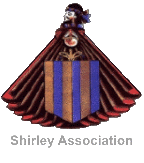

 |
 Chartley
Cattle Chartley
Cattle England |
|
|
|
The Story of the Chartley Cattle The Chartley herd of white cattle dates back to about 1248 when, it is recorded, "some of the wild cattle of the county of Staffordshire which had roamed at large in the Forest of Needwood were driven into the park at this place where their breed is still preserved". (History of Tutbury, 1832). The descendants of these cattle remained in Chartley Park until 1905, when the 10th Earl Ferrers sold them. Over the years the numbers of animals in the herd at any one time have varied considerable. There used to be a tradition, so history relates, that the number in the herd could not be raised above twenty-one and there is no evidence to show that the number in the herd ever did exceed that number before the nineteenth century. However, there are records which show that during the nineteenth century this number was considerably increased, and it is much higher today. In 1851, there were forty-eight animals in the herd, but in 1877 there was an outbreak of tuberculosis which resulted in the number dropping to twenty; however, by 1900 they had risen again to fifty. In 1902 the number had dropped to fourteen, and by 1805, there were only eight or nine animals left in the herd. In December 1904, it was decided that the herd should be sold. No one quite knows why this decision was taken unless it was considered a way of preserving the breed by changing the environment and management. So was to end, for a time, the association which this wild breed of cattle, indigenous to England, had had with the Ferrers family for some 700 years. The herd was put up for sale with a Reserve Price of $1000 pounds. However, this figure was not reached. There was only one bid and that was for a mere $100 pounds for the whole herd. There herd was withdrawn from the sale, but it was later sold privately and the Duke of Bedford. There followed a sorrowful and traumatic episode in the history of the cattle. The animals, some seven in number, were put onto railroad wagons to be send to Worburn, the Duke's home, but the straw which was in the wagons in which the cattle were put, caught fire and most of the animals were badly burned and some died. When they eventually arrived at Woburn, there was only one bull which could be used at all. He did not live long for, so terrifying was the fire that the bull panicked in the melee and knocked his horns off; the stubs subsequently became diseased and he died. The Duke of Bedford decided, therefore, to cross the remaining Chartley cattle with the Longhorn, both to infuse new blood into the herd and as the only means of keeping the herd going. However, the charley herd as it is today has reverted to its original type, because the characteristics of the Chartley breed are so strong and dominant, and there is little evidence of the difference between the original herd and the present-day Chartley cattle. This can be verified, not only from photographs which were taken of the herd when they were still at Chartley, but also by the fact there is a complete specimen of a Chartley bull on a stand and stuffed that use to be at Staunton Harold but is now at the Earl Ferrers home. (We saw this stuffed bull in 1986 when our group of American Shirleys visited the home of the Earl Ferrers). |
In 1970, the present Earl Ferrers bought back the whole of the Chartley herd, which was at Woburn, from the Trustees of the Bedford Estates. At this time there were twenty-four animals. Four months later when the cattle arrived, the number had increased to thirty-three. In the early part of this century, one of the dukes of Bedford was President of the Zoological Society of London, and he gave some of these rare Chartley animals to the Zoo at Whipsnade. This herd at Whipsnade had, in turn, gradually grown to about seventeen in number and in March 1973, this herd was also bought by Lord Ferrers. Thus were reunited the two main branches of the Chartley herd and, after a break of some 65 years, the herd has returned to the family in whose care it had been for some 700 years. The characteristics of the Chartley breed are very marked. They are predominantly white cattle with ears, muzzle and feet black, and there is a splash of black on the front of each fetlock. Their horns are long and white with black tips; there should be a thin line of black above each eye like a thin mascara-like line of an eyebrow. Some animals have black flecking on the skin underneath the coat. The white coat is thin and silken during the summer, but this is replaced by a thicker coat for the winter. One of the most attractive sights to see in the young calves in the spring - snow white animals, with bright faces and black ears and noses. Occasionally, an all-black calf is born, and in the 'olden days' when this happened, the calf was instantly slaughtered as there used to be a legend which said the the birth of a black calf meant the death of a member of the Ferrers family within a year. So it is that the 'wild' indigenous cattle, which roamed the forests of Britain at the of William the Conqueror and afterwards, can to this day still be seen as a herd, not just as a relic or memory of the past. |
||
|
All Rights Reserved |
|||